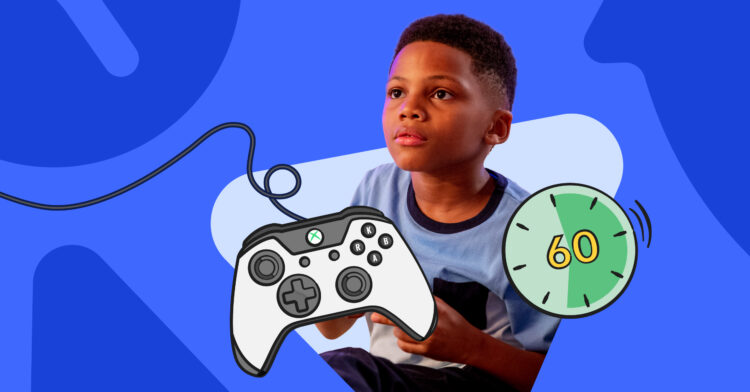Are you concerned about how much time your kids spend on gaming? Learn how to create a balance and foster healthy screen habits for your children.
You can teach them good gaming practices – from developing strategies to understanding the importance of taking breaks. Let’s explore the best ways to introduce gaming into your family’s lifestyle in a positive manner.
Page Contents
Benefits of Gaming
It can provide children with many benefits, including education, physical activity, increased hand-eye coordination, and mental stimulation. Educationally, it can help kids practice problem-solving skills and increase focus and concentration. Different types of games can also stimulate artistic expression or encourage the development of language skills.
In addition to educational benefits, it may aid in physical development. Technology is increasingly being used to promote healthy activities such as biking and sports simulations. Motion-capture technology allows gamers to interact more actively with their favorite characters and enjoy a full-body experience while they are engaging with a title.
ExpressVPN’s study on gaming habits provides insights into the landscape according to your age. That being said, gaming can also be advantageous when it comes to practicing hand-eye coordination — movements like strategies used in puzzles, aiming virtual weapons for accuracy, or maneuvering a character around obstacles help people hone these skills faster than ever before in an entertaining context.
Finally, when played wisely, gaming can be beneficial for both mental fitness and stimulating creativity by providing a safe environment for the exploration of consequences versus rewards — the player must take risks in order to win the game.
Choosing the Right Games
When selecting age-appropriate games, there are a few things to consider. The Entertainment Software Rating Board (ESRB) provides several ratings for video games such as “E for everyone,” “T for teen,” and “M for mature” to help you choose the appropriate game.
These ratings identify content that may contain violence, language, or sexual themes that may not be suitable for very young users. It’s important to read online reviews and discuss the content of games with your child before deciding on a title. Additionally, look into the multiplayer nature of certain titles and consider whether they are being monitored or moderated by adults before making a purchase.
Parents should also familiarize themselves with the parental control settings on gaming systems and mobile devices in order to restrict access to inappropriate content as well as spending limits on in-game purchasing. Additionally, some games include microtransactions which allow players to make purchases directly from within the game itself –so it is important to keep an eye out for these features and take steps if necessary to limit their use.
Finally, be sure that any game your child plays is age-appropriate and offers educational opportunities rather than encouraging unhealthy competitive habits or excessive violence or aggression.
Setting Time Limits

Source: bark.us
Setting time limits is an important part of encouraging healthy gaming habits in children. Young people should be allowed to enjoy their digital activities and reap the benefits, such as social interaction and problem-solving in virtual scenarios, but it’s important to keep tabs on how they spend their time.
Allowing children to spend too much time gaming can lead to unhealthy behavior, including missing out on meals or physical activity, neglecting other activities, or feeling socially isolated. Additionally, some violent video games could have a negative impact on a child’s mental well-being.
Time limits for gaming can be enforced through various methods: setting daily timers for each game session; scheduling dedicated gaming “breaks” that occur at the same times every day; granting rewards (like extra playtime) for completing other tasks first; or using parental control settings built into most systems. Parents should also practice what they preach by limiting their own game time too! Creating these boundaries means more balance in life and encourages better decision-making when kids do select a game to play.
Taking Breaks
Taking regular breaks is important for both mental and physical health when it comes to gaming. Children need time away from screens to refresh, reset, and rejuvenate. Encouraging them to take breaks will help them stay focused on the game or activity so they won’t fatigue quickly.
Discuss with your kids the importance of taking a break every hour while gaming and give some ideas of activities they can do during this time such as taking a walk, playing outside, doing a quick workout routine, or calling a friend or family member.
Not only will breaks prevent burnout, but they will also help children avoid developing other conditions that can come with extended screen time such as headaches, neck pain, and eye strain. Setting reminders or game timers can be helpful in getting kids to take those necessary breaks. When they don’t have someone helping keep track of these short pauses throughout their playtime, there are now several apps that can do it for them.
Monitoring Progress

Source: edusuite.pk
As a parent, it can be difficult to help your child establish healthy gaming habits. It’s important to monitor their progress in order to help them stay on track and prevent them from developing issues with excessive gaming. Here are some recommendations for monitoring their progress:
- Be aware of how often they play and when. Ask questions about which games they like and track the hours spent on each one.
- Discuss their habits with them frequently and express your concerns if you think they’re spending too much time playing.
- Set realistic goals for how long and when your child will play games, including setting time limits if necessary.
- Check-in with your child regularly about their gaming experiences, to make sure that they’re safe and not being exposed to anything inappropriate or harmful content. Try engaging them in more constructive activities such as sports or volunteering.
- Talk with other parents in your area who have children the same age as yours—sharing information can help everyone understand the potential dangers of online gaming while also providing examples of healthy ways children can use technology responsibly.
Conclusion
In conclusion, it is clear that playing online and video games can offer children a range of social, educational, and physical benefits. While there are risks associated with gaming, these can be addressed through responsibility on the part of both parents and children.

Source: gamequitters.com
By monitoring their play time, setting forth rules around acceptable content, and engaging in regular conversations about the consequences of gaming, both parents and kids can use gaming as a positive way to bond over hobbies without falling into unhealthy habits or patterns.





